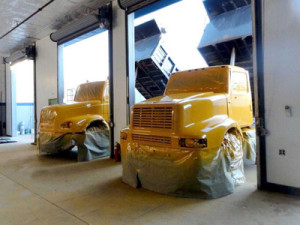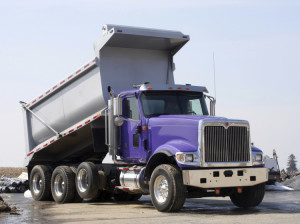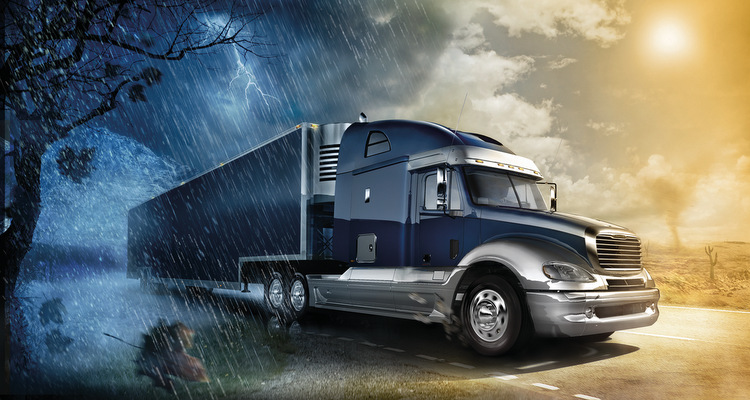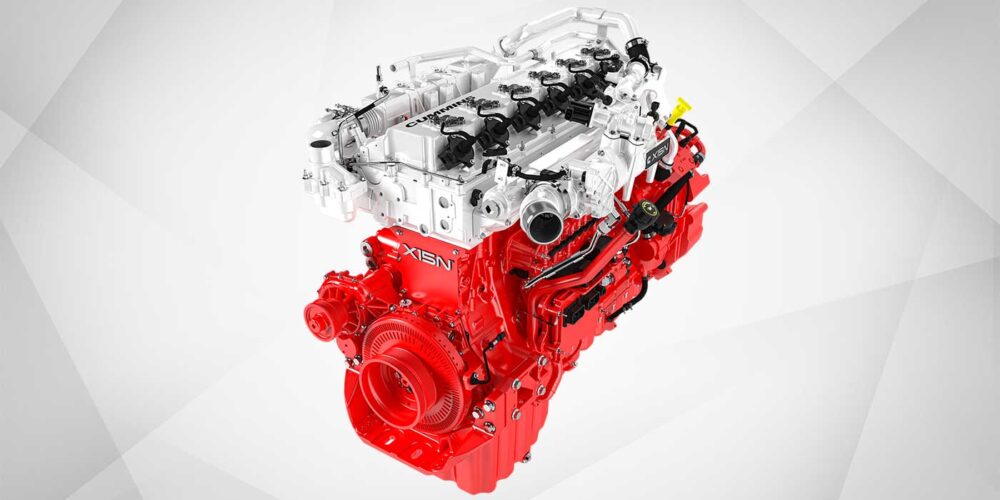Those smooth lines. That clean finish. Is there anything more inspiring than a beautifully finished truck ready to hit the road and get the job done? In today’s trucking industry, a well-maintained truck finish reflects the detail-oriented, hard-working philosophy of the fleet. But every day your rolling road warriors are fighting a battle against road stones, gravel, harmful UV rays, road-treating chemicals and environmental fallout like tree sap, bird droppings and even acid rain. They chip, scratch and cut down to the vehicle substrate, unleashing the truck finish’s most destructive agents—rust and corrosion.

“Any chips or scratches that go down to the substrate are a direct path for salt or moisture to attack that metal. Once that metal is exposed, there’s nothing stopping it from corroding,” says Dan Szczepanik, global fleet product manager at Sherwin-Williams. “The biggest consequence of not keeping up on a damaged finish is first your outward appearance. In a business-to-business world, it’s more of a perceived risk for any potential client. That’s a huge consequence to a fleet’s business. On the other side, you have the cost to repair. If you find something early, it’s going to be cheaper than if you let it go.”
The right finishing products and proper preventative maintenance can keep your business billboard on wheels productive and profitable by radiating an aura of confidence and professionalism.
Today’s heavy-duty truck finishes have to defend themselves against some of the toughest and harshest agents of corrosion the industry has ever seen. For the northern part of the country that has to deal with snow and ice, new road salts—not just the traditional sodium chloride rock salt, but liquid magnesium chloride liquid calcium chloride—are applied wet and can incorporate an adhesive. The idea is that the chemicals will stick to the road, but they’ll also stick to your trucks, eating away at your pristine finish. These days, corrosion creeps into vehicle substrates sooner than ever before.
It doesn’t take much for corrosion to find its way down to the vehicles substrate through the finish’s weakest areas. Moisture and other chemicals will begin to attack the substrate to coating interface, weakening the bond of the primer causing premature adhesive failure of the coating system. Fran Cassidy, commercial fleet business manager for Axalta Coating Systems, explains that for non-metallic surfaces, a scratch or crack in a surface could result in the weakening of the composite resulting in potential part replacement and paint delamination.
“If the substrate is a type of metal—i.e. steel or aluminum—oxidation will begin. Areas especially vulnerable have dissimilar metals in contact with one another—attachment hardware as an example,” says Andrew Hetchler, marketing director of commercial coatings for PPG Industries, stressing the importance of proper maintenance. “The price for a gallon of quality paint can quickly become inconsequential compared to the cost of prematurely repainting a large commercial vehicle. Items to consider in total costs are vehicle downtime, delivery costs to a qualified repair shop, removal of corrosion and old paint finishes, repair welding, part and hardware replacement, remounting and vehicle reassembly.”
Obviously, you want to protect your trucks, and you do that by keeping close tabs on the finish during your maintenance checks.
“Keeping the unit clean of road salts, bugs, and fuel spillage, among other dirt and debris, will help you avoid major paint issues, and routine preventative checkups are vital,” said Lars Eckberg, technical consultant for ChemSpec Paint, a global manufacturer of coatings for the automotive, fleet and industrial markets. “When a substrate becomes exposed, this begins a process of corrosion. Corrosion causes the integrity of the surface to begin losing adhesion and continues until the surface is repaired properly.”
Start with the basics. Regularly wash your trucks rinsing off any mud, debris, chemicals, fuels and anything else that might impact the finish. A daily rinse after a hard days work is encouraged. Be sure to wash off the wheels, tires and undercarriage while you’re at it. You basically want to wash off any areas in the “hot zone,” Szczepanik explains—the 48-in. from the road up the truck.
“For the trucks that are going to be driving through winter climates, it’s best to be checking before and after the winter to look for any scratches, cracks or anything like that. Road salt can lead to potential corrosion and make that repair larger,” says Brian Calmer, Martin Senour product manager. “Some of the other things—specifically for cement work trucks they have a preventative maintenance where they will apply muriatic acid solution to remove the cement off the coating—that’s something that’s good for that specific application, but you have to make sure that your coating has chemical-resistance for that as well.”
For a true clean, power washing might not be enough. You want to clean the truck, not push the dirt and salt into the truck’s nook and crannies. You’re going to need a proper detergent to clean the truck. Cassidy recommended utilizing a proper PH cleaning solution. You want to stay away from any cleaning agents that are extremely acidic or extremely basic.

Green with environmental efficiency
For all paint and finish manufacturers, meeting and even exceeding environmental legislation for volatile organic compounds (VOC) is a top priority. PPG, for example, reportedly spends more than $400 million, annually, in research and development to design proprietary resins systems and technologies allowing them to closely control the chemistries of its products to meet VOC regulations, as well as specific customer end use requirements.
Sherwin Williams reported that it works with its suppliers and design its own resins to constantly improve through more renewable products, lower VOC products and chrome-free products. “Lowering VOC’s is the right thing to do. Eliminating chrome usage, reducing phosphates is also the right thing to do,” said Dan Szczepanik, global fleet product manager at Sherwin-Williams.
For example, anti-corrosives, nano-technology and bio mimicry allows paint manufacturers to achieve greater corrosion protection while being more environmentally safe.
Paint, finish options explained
Whether you’re looking to refinish one truck or all of the trucks in your fleet, you have a wide range of options that not only impact the truck’s durability, but its outward appearance as well. First and foremost, you have to consider the quality of the paint you’re putting on the truck. There’s a difference between a single stage and a basecoat, clearcoat product in both durability and price.
“With the basecoat, clearcoat, you’re going to get more longevity, typically you’re also going to get more impact resistance. You’re paying more, but you’re getting more value there,” says Calmer.

Cassidy echoes that sentiment, saying, “If the assets are expected to be part of the fleet for greater than five years or may be exposed to extreme conditions, a basecoat, clearcoat system should be considered. A basecoat, clear coat system provides the truck with an enhanced degree of durability and gloss retention that will outlive the life of the truck in the most extreme of conditions.”
You’ll also want to ask about different coating options and protections. Sherwin Williams, for example, offers its Genesis single-stage HP, focusing on the speed of the application. Szczepanik explains that it is a direct gloss that can be air-dried and hand-slicked in less than 10 minutes.
Martin Senour touted its chemical resistance option, as well as its UV resistance. If you’re going to get into bright colors or metallic, UV resistance is something you’re going to want to have if you’re going to be in business for a long time and you don’t want to deal with repairing coatings or repainting.
“I’d probably say that’s one of the reasons you see a lot of white trucks out there on the road, especially if you look down south,” Calmer says.
PPG pointed to its experience in extending the durability and corrosion protection for the automobile into the commercial vehicle segment, working both at OEM, repair, and refurbishment levels to marry recommended coating systems with the overall painting and assembly process. Depending on your coating and color needs, they can be met with the premium Delfleet Evolution paint system with a full color palette for spot repair in basecoat or single-stage topcoats or the Delfleet Essential economical paint system, also in single stage and basecoat options, targeted at overall repairs or refurbishments.
ChemSpec offers its Metacryl Color Topcoat—a universal intermix system with the ability to produce a multiple range of topcoats using one common set of toners. This system allows fleets to formulate thousands of colors while meeting specific production demands and increasing the bottom line.
For Axalta’s part, it recently introduced its Rival single-stage poly-
urethane, which is aimed at providing a mix of price and value for commercial segment, and its Imron Elite is available in both a single stage and basecoat, clearcoat qualities are used on the heavy-duty truck and transit vehicles OEM production line, as well as in aftermarket repair and maintenance, allowing “repair-in-kind” capability to achieve an original factory finish.
Keep in mind that the cost of the paint is typically a fraction of the finishing cost. The biggest cost is the labor—the taping, the sanding, cleaning, and so on. Clearly, there’s no shortage of coating options and that’s before you consider color.
A kaleidoscope of color
Choosing the correct color is about more than just picking your favorite. You want something that makes sense for your business and your brand. Often times, the first impression your trucks will make, other than being on time, will be how they look and how that relates back to the business you are building.
“Giving great phone customer service, a great price and then using a vehicle with poor gloss, corrosion, fading, mismatched color, etc. does not provide for brand unity throughout the experience,” said Andrew Hetchler, marketing director of commercial coatings for PPG Industries. “You may leave people wondering what else they are missing or need to look into further. And for every actual customer, you have many more potential future customers seeing your fleet on the road, forming an opinion about your company and your business long before they even interact with you.”
The first step is to establish a color position for all of your colors used, including stripes and accent colors. This should be aligned and unified throughout the company, including signs, stationary, business cards, advertising, etc.
“Choosing a color needs to tie back to the brand image that the company is trying to present to the market place,” says Cassidy. “For example, companies in the construction segment are looking to deliver a message around safety. These companies choose yellows and reds that are easily visible and relatable to safety in the eye of the public. Other companies that position themselves as being environmentally conscious choose bright green colors to create awareness that reducing their impact to the earth’s resources is one of their top priorities.”
You’ll want to work closely with your chosen finish solutions partner. Szczepanik explains that while there are seemingly endless color options, some hues may not be available.
“For many companies these days, the color is trademarked,” he says. “You have to make sure that you have the specific color and that you maintain it. You can be assured that Sherwin Williams has fleet specifications in which we’ve taken the color, we’ve gone to the owner of the fleet and they’ve signed off on the correct color that meets the brand standards, both in maintenance and getting the correct color for repairs.”
It can be frustrating when you have several trucks side by side and a couple of them stand out as not having the correct color formula. There’s no such thing as “close enough” in the color world, even a color that seems to match in daylight can stick out like a sore thumb when the vehicle is pulled into a warehouse or shop with fluorescent lighting that will call out the truck’s non-uniform color.
Partnering with a paint solutions systems provider is the best way to ensure that you are getting the correct colors for refinishing or repairs.














